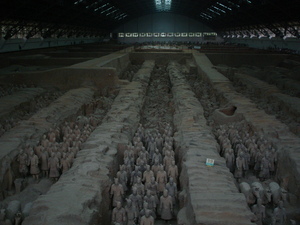The train arrived at our destination, the city of Xian, at around eight in the morning. We departed and headed by bus straight to our new hotel for breakfast. The meal was the closest we’ve had to an American style. We could choose to have hot milk, warm milk, or coffee to drink, and were served a salad (odd for breakfast, but at least the veggies were fresh), toast, and a sunny side up egg. The toast came in a sandwich with bright pink filler that we think was just dyed butter.
Our hotel is located near the center of Xian, which is marked by two structures, separated several hundred feet away. These are a bell tower and a drum tower, whose sounds were used to signal morning and night to the city’s people.
Xian was a key city to China’s first emperor–a man who unified through force half a dozen separate nations and created a feudal society. Our first tour took us through an early winter palace of Chinese emperors, of which the most remarkable infrastructure is a series of bathing rooms for the Emperor and his entourage. Hot water passed through underground channels first through the Emperor’s bathhouse, then to that of the concubines, and lastly to that of the eunuchs.
We love our ice cream!
Our next destination was the burial complex of China’s first emperor. While it is believed that a small city once exited at the site, all that remains now is the towering man-made mountain under which the Emperor’s tomb lies. This tomb is supposedly expansive and elaborate–with booby traps to prevent unwanted guests and a flowing river of mercury. While modern sensing technology has suggested that there is some sort of a cavern in the mountain, and mercury levels in the area’s soil are extremely high, the Chinese have decided to wait to attempt an excavation until they have the technology to avoid any possible booby traps and prevent the damage that a sudden exposure to outside conditions would surely cause. However, they have created a model in keeping with descriptions of the chamber from the time of its construction, which we were able to walk through. In addition to the river of mercury, the tomb supposedly had a black roof with embedded jewels forming star constellations as well as priceless artifacts spread throughout.
The most well known part of the tomb’s grounds are the clay terra cotta warriors, which were buried under farmlands until just a few decades ago. In fact, the farmer who made the discovery while digging a well has a stand at one of the tourist shops. Supposedly he was well rewarded when the government seized his land for excavation. One would hope that this would be true of the discoverer of the “eighth wonder of the world.”
Some 8,000 terra cotta warriors exist, but the vast majority remain buried. Again, this is because the Chinese want to wait until they have the technology to properly preserve the ancient artwork. When excavated at present, the colors of the terra cotta fade within just minutes of being exposed to the air.
The statues are found at three separate sites, all of which have been contained under warehouse-like structures. The warehouse labeled as the first is the largest and most impressive, with row upon row of foot soldiers and a few horses. More varieties are found at the other sites, including archers, generals, and horses for mounting and pulling carriages.
They look like figurines until you see them relative to a person
Note the individualized faces
Our last location of the day was a park-like square of Xian, complete with a shallow pond that visitors can traverse without getting their shoes wet via a series of concrete pathways.
Some great signage
We still have two days in Xian, with plenty more sights to come!
Location: Xian, China
Loading map...










